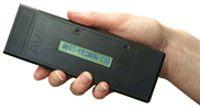Microchip Companies Cite Irreconcilable Frequencies
If you'll remember, a scanner uses radio waves to read the number encoded in a microchip. Just as you find your favorite radio stations by tuning into the right frequency, scanners need to be able to read the correct frequency to obtain this number. The problem is pet microchips come with different frequencies, such as 125 kHz, 128 kHz and 134.2 kHz. About 98 percent of the pet microchips in America use 125 kHz, whereas those in Europe use 134.2 kHz [source: USDA].
In 1996, the International Organization for Standardization (ISO), headquartered in Switzerland, adopted the 134.2 kHz frequency for pet microchips in an attempt to solve incompatibility problems. However, the United States was already largely using the 125 kHz microchip, and critics pointed out that changing to the ISO standard would be difficult and expensive.
Advertisement
Even though universal scanners (also known as "forward and backward reading" scanners) exist that can read different frequencies, most animal shelters don't have these scanners. To make matters more complicated, companies that make microchips don't want this universal scanner to be compatible with their equipment. These companies want people to continue buying their scanners and microchips, so they make sure that only their scanners can read their microchips. They do this by encrypting the frequency at which the microchip is read. Through encryption, companies make it so only scanners with the correct algorithm can decode the radio signal emitted by the microchip. Crystal Import, a company that distributes ISO-compatible microchips even filed a lawsuit against the pet microchip companies AVID and Digital Angel claiming their tactics violated antitrust laws, seeking to force them to reveal the encryption code [source: O'Connor].
Fed up with companies that continue to use the 125 kHz frequency and encrypt their microchips, Banfield pet hospitals jumped on the ISO bandwagon in 2004 and began to implant thousands of pets with microchips that use the ISO 134.2 frequency. However, Banfield didn't anticipate the problems this would create for American pet owners. Because most U.S. shelters don't have ISO-compatible scanners, they might scan a pet and fail to detect a microchip. That's exactly what happened in one tragic instance: A pet owner called a shelter literally half an hour after it had put her microchipped dog to sleep [source: AMACA]. After this heart-breaking mistake was made, a California court made Banfield stop implanting ISO-compatible chips in pets. Now, Banfield recommends that your pet get two microchips -- both an ISO-compatible (134.2 kHz) chip and one with the 125 kHz frequency common to the U.S. [source: Banfield].
To help alleviate the frustrations that come out of this incompatibility, President Bush signed a bill in 2006 that charged the Animal and Plant Health Inspection Service (APHIS) with standardizing microchips. However, APHIS only exercises authority over organizations that are regulated by the Animal Welfare Act (AWA), which means it does not have the power to dictate what private pet owners and retail businesses do [source: USDA]. The bill does, however, mean that it can work to help standardize the microchips used in facilities or entities regulated by the AWA, which include animal exhibitors and animal dealers [source: USDA].
What's perhaps worse than the scanner problems, though, is evidence that microchips might cause cancer in animals. Read the next page to find out whether microchips are a health risk to pets.
